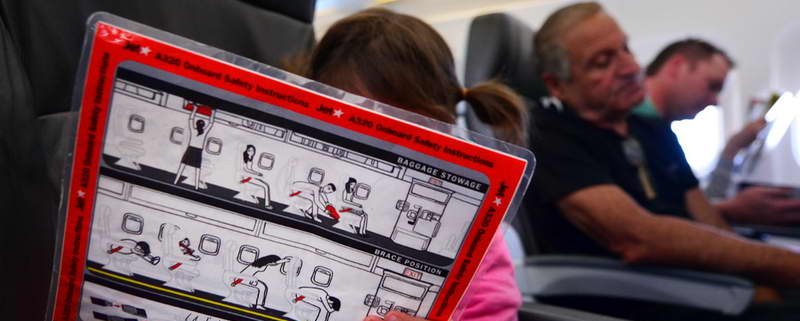Are safety information cards required for every seat?
How many safety information cards are required in each seat row?
There is a regulation that requires the certificate holder to have a safety information card located at each exit seat.
- 14 CFR 121.585 Exit seating.
(d) Each certificate holder shall include on passenger information cards, presented in the language in which briefings and oral commands are given by the crew, at each exit seat affected by this section, information that, in the event of an emergency in which a crewmember is not available to assist, a passenger occupying an exit seat may use if called upon to perform the following functions:
However, for all other seats, 121.571 applies, and you’ll find that the requirements for passenger safety information card quantity is rather vague per the regulation, as it states below “in convenient use for of each passenger,” not “one per seat.”
- 14 CFR 121.571 Briefing passengers before takeoff.
(b) Each certificate holder must carry on each passenger-carrying airplane, in convenient locations for use of each passenger, printed cards supplementing the oral briefing. Each card must contain information pertinent only to the type and model of airplane used for that flight, including—
That said, there is another factor to consider; airplanes are supposed be configured in accordance with the LOPA, submitted during certification of the aircraft and/or configuration change, notwithstanding the Minimum Equipment List and Non Essential Furnishings. The condition it was in at the time of certification, including emergency equipment, briefing cards, etc., is how an airplane is generally supposed to be configured for every flight. That said, whenever a passenger seat is missing a safety information card, it should be replaced from the stock onboard the aircraft. If there are no more cards available on the airplane, place the remaining cards in a way that all passengers in that seat group have access to a safety information card. Additionally, upon arrival at the next available station that has an additional supply of safety information cards, request restock your supply kit. When you receive the additional supplies, ensure that the revision date on the cards is the most current version as found on the plane. Blending outdated safety information cards with current ones can lead to a regulatory violation. It’s better to share cards in a seat row that are current than for each seat to have a card, but one or more cards are not current.





Thanks for sharing this Don.
Yes safety information card per pax seat is mandatory.
Some regulations also allow a placard of SIC on seat back.. what’s your view on that.
Hi Sudeep,
Having a safety information card that shows all identical information, just placarded to the seat in front would be unique to me; I’ve never heard of or encountered such a design. Not that I have been on every airline, it just sounds unusual. However, there can be an upside and downside to such an arrangement.
From a compliance standpoint, having the safety card placarded in front of each seat ensures every seat will have all the information and there would be no concerns of them being taken or accidentally thrown out in the trash. However, there are some negatives to attend to. Being a placard and not a replaceable card, and considering that not every traveler is a kind, courteous traveler, some placards are likely to be written on or scratched. Then there’s the concern of card revisions. Would new safety information card placards be placed over the old ones, or remove the old and apply the new ones?
If the safety regulations permit for it, I don’t see why it couldn’t be done. It would just have some additional considerations for maintenance of the cards and regular monitoring.